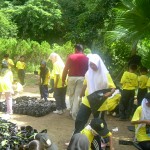Going green in Langkawi
By CLARISSA CHOU, 27 October 2007
Parts of Pulau Langkawi just got greener, with fruit-bearing trees being recently planted to nurture wildlife.
Three HSBC Bank Malaysia Bhd staff members – Jennifer Leong, Leong Li Yim and Kee Thuan Lye – got the project off with help from Langkawi nature tour group Natural History Expeditions and Malaysian Nature Society (MNS).
The trio were volunteers with Earthwatch Institute last year, where they joined field research teams from around the world. HSBC sponsors several employees for the Earthwatch volunteer scheme each year. Following their stints abroad, the participants must conduct a local “community care” project, using US$550 (RM1,925) which had been set aside from each of their sponsorships.
Jennifer Leong, a manager in the HSBC marketing team, said they chose to plant trees in Langkawi after considering various suggestions from the MNS.
Late last month, they headed to Langkawi together with three colleagues and two MNS staff membes. There, they were joined by three guides from Natural History Expeditions, who had obtained the tree saplings and chose the planting site in the north-western part of the island.
The group spent a day planting some 50 seedlings along Jalan Datai, including on cleared and idle land in the area. Another 50 trees were given to Bon Ton Restaurant, Red Tomato Cafe and Casa Del Mar Resort for planting on Pantai Cenang on the western coast of the island.
“The trees chosen were those which bear fruits, to be eaten by the majority of animals on the islands, so benefiting more wildlife,” said Leong.
Naturalist and guide Irshad Mobarak of Natural History Expeditions hoped the planting of more trees would bring birds back to the developed areas of Pantai Cenang. The trees were chosen with care. Pokok samak (called salam in the mainland) will bear fruits two to three times a year, the Malaysian cherry tree (Muntingia calabura) would bear fruit within a year, while pokok cenderai is a local species.
“These are trees which will benefit both man and wildlife as they provide shade as well as food. They feed the smallest to the biggest animals, from sunbirds to hornbills, monkeys and squirrels,” said Irshad Mobarak.
The tree-planting, he explained, was part of a bigger scheme to green the island, which would include reforestation of Gunung Raya.
“We have 100 school-kids collecting seedlings and growing them in a nursery. We hope to get 3,000 seedlings by next year for planting. These trees will provide food and nesting habitat for hornbills and other wildlife,” said Irshad.
For Leong, the day spent planting trees under the hot sun was one of her most fulfilling island getaways. “We did not just plant trees for the sake of doing something. The trees we planted will sustain and preserve animals during their lifetime of 30 to 40 years,” she said.
The HSBC staff intend to return to Langkawi a year from now to see how the trees have fared. In the meantime, Irshad’s group will be keeping a close watch on the saplings.
 Previous Post
Previous Post Next Post
Next Post







